Women Studies Essay: Exploring Gender, Race, Class in Women's Studies
VerifiedAdded on 2022/08/19
|5
|1216
|14
Essay
AI Summary
This essay explores the critical importance of studying women, emphasizing the historical neglect of women's issues in academic research and societal structures. It highlights the necessity of understanding women's experiences to address gender inequality. The essay defines and analyzes the concepts of feminism, misogyny, and patriarchy, tracing their historical development and societal impacts. It also examines the significance of gender, race, and class in shaping women's experiences and influencing the discourse surrounding women's studies. The essay draws on sociological perspectives and relevant literature to provide a comprehensive overview of these interconnected issues, offering insights into the challenges and complexities of women's lives.
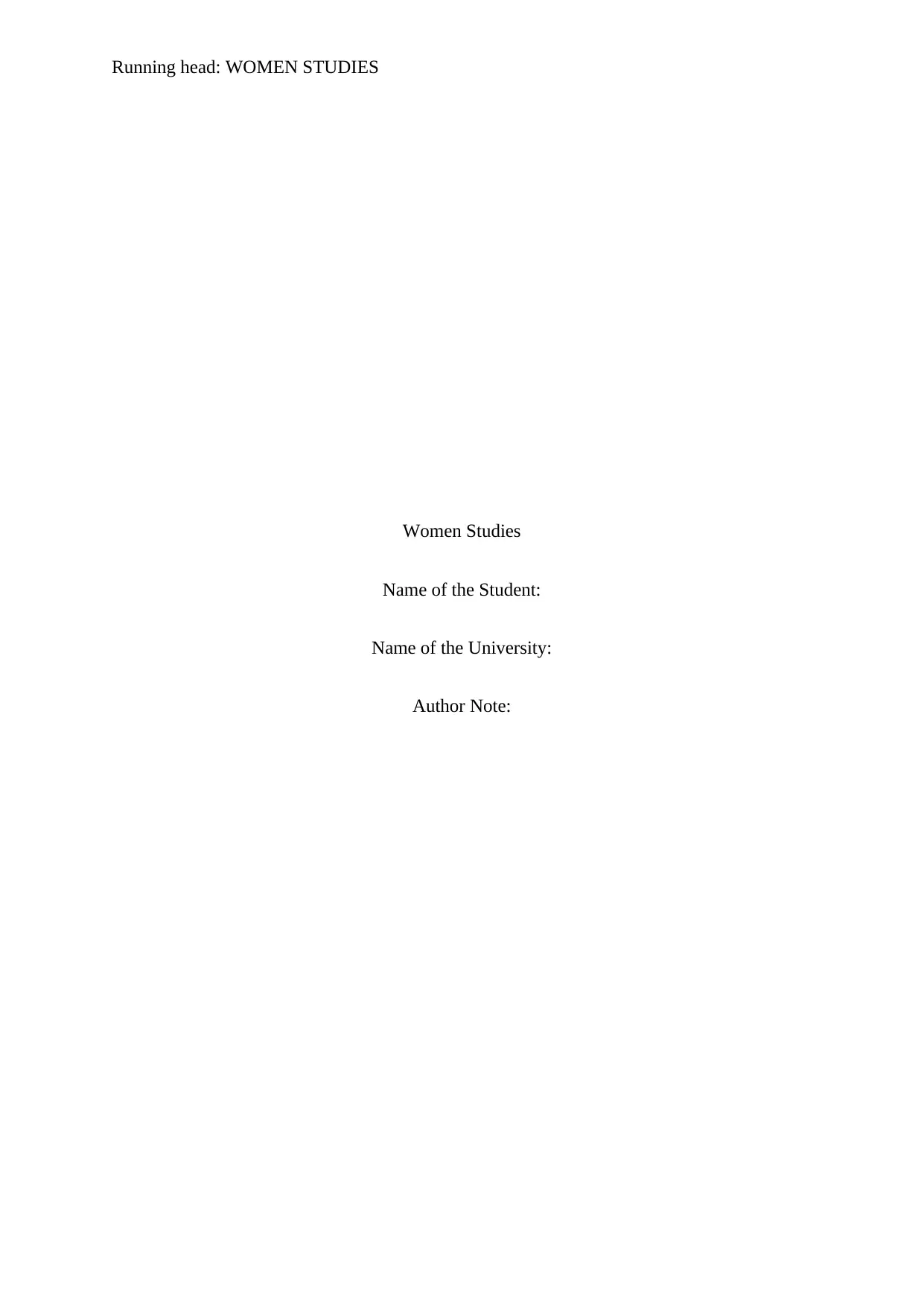
Running head: WOMEN STUDIES
Women Studies
Name of the Student:
Name of the University:
Author Note:
Women Studies
Name of the Student:
Name of the University:
Author Note:
Paraphrase This Document
Need a fresh take? Get an instant paraphrase of this document with our AI Paraphraser
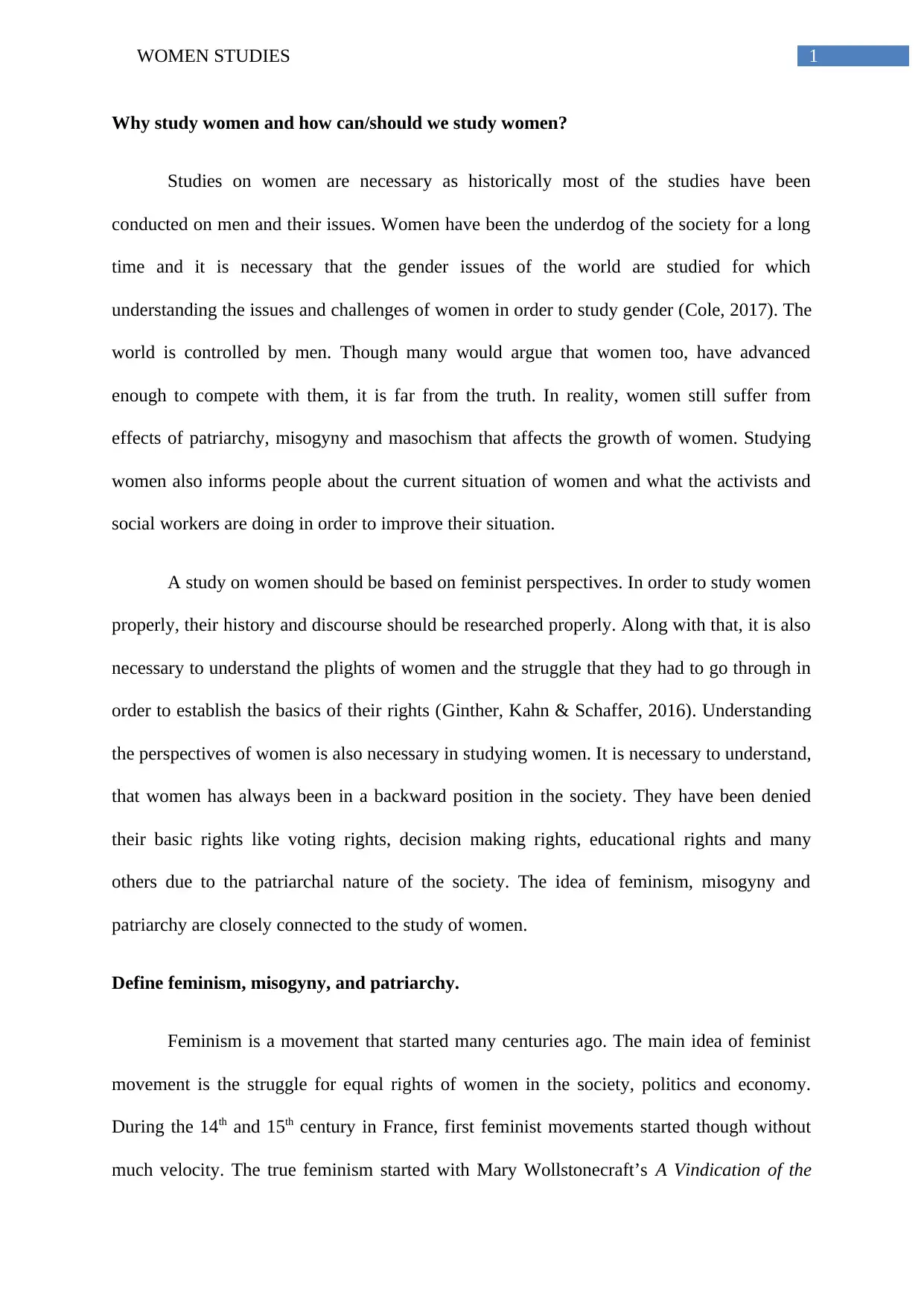
1WOMEN STUDIES
Why study women and how can/should we study women?
Studies on women are necessary as historically most of the studies have been
conducted on men and their issues. Women have been the underdog of the society for a long
time and it is necessary that the gender issues of the world are studied for which
understanding the issues and challenges of women in order to study gender (Cole, 2017). The
world is controlled by men. Though many would argue that women too, have advanced
enough to compete with them, it is far from the truth. In reality, women still suffer from
effects of patriarchy, misogyny and masochism that affects the growth of women. Studying
women also informs people about the current situation of women and what the activists and
social workers are doing in order to improve their situation.
A study on women should be based on feminist perspectives. In order to study women
properly, their history and discourse should be researched properly. Along with that, it is also
necessary to understand the plights of women and the struggle that they had to go through in
order to establish the basics of their rights (Ginther, Kahn & Schaffer, 2016). Understanding
the perspectives of women is also necessary in studying women. It is necessary to understand,
that women has always been in a backward position in the society. They have been denied
their basic rights like voting rights, decision making rights, educational rights and many
others due to the patriarchal nature of the society. The idea of feminism, misogyny and
patriarchy are closely connected to the study of women.
Define feminism, misogyny, and patriarchy.
Feminism is a movement that started many centuries ago. The main idea of feminist
movement is the struggle for equal rights of women in the society, politics and economy.
During the 14th and 15th century in France, first feminist movements started though without
much velocity. The true feminism started with Mary Wollstonecraft’s A Vindication of the
Why study women and how can/should we study women?
Studies on women are necessary as historically most of the studies have been
conducted on men and their issues. Women have been the underdog of the society for a long
time and it is necessary that the gender issues of the world are studied for which
understanding the issues and challenges of women in order to study gender (Cole, 2017). The
world is controlled by men. Though many would argue that women too, have advanced
enough to compete with them, it is far from the truth. In reality, women still suffer from
effects of patriarchy, misogyny and masochism that affects the growth of women. Studying
women also informs people about the current situation of women and what the activists and
social workers are doing in order to improve their situation.
A study on women should be based on feminist perspectives. In order to study women
properly, their history and discourse should be researched properly. Along with that, it is also
necessary to understand the plights of women and the struggle that they had to go through in
order to establish the basics of their rights (Ginther, Kahn & Schaffer, 2016). Understanding
the perspectives of women is also necessary in studying women. It is necessary to understand,
that women has always been in a backward position in the society. They have been denied
their basic rights like voting rights, decision making rights, educational rights and many
others due to the patriarchal nature of the society. The idea of feminism, misogyny and
patriarchy are closely connected to the study of women.
Define feminism, misogyny, and patriarchy.
Feminism is a movement that started many centuries ago. The main idea of feminist
movement is the struggle for equal rights of women in the society, politics and economy.
During the 14th and 15th century in France, first feminist movements started though without
much velocity. The true feminism started with Mary Wollstonecraft’s A Vindication of the
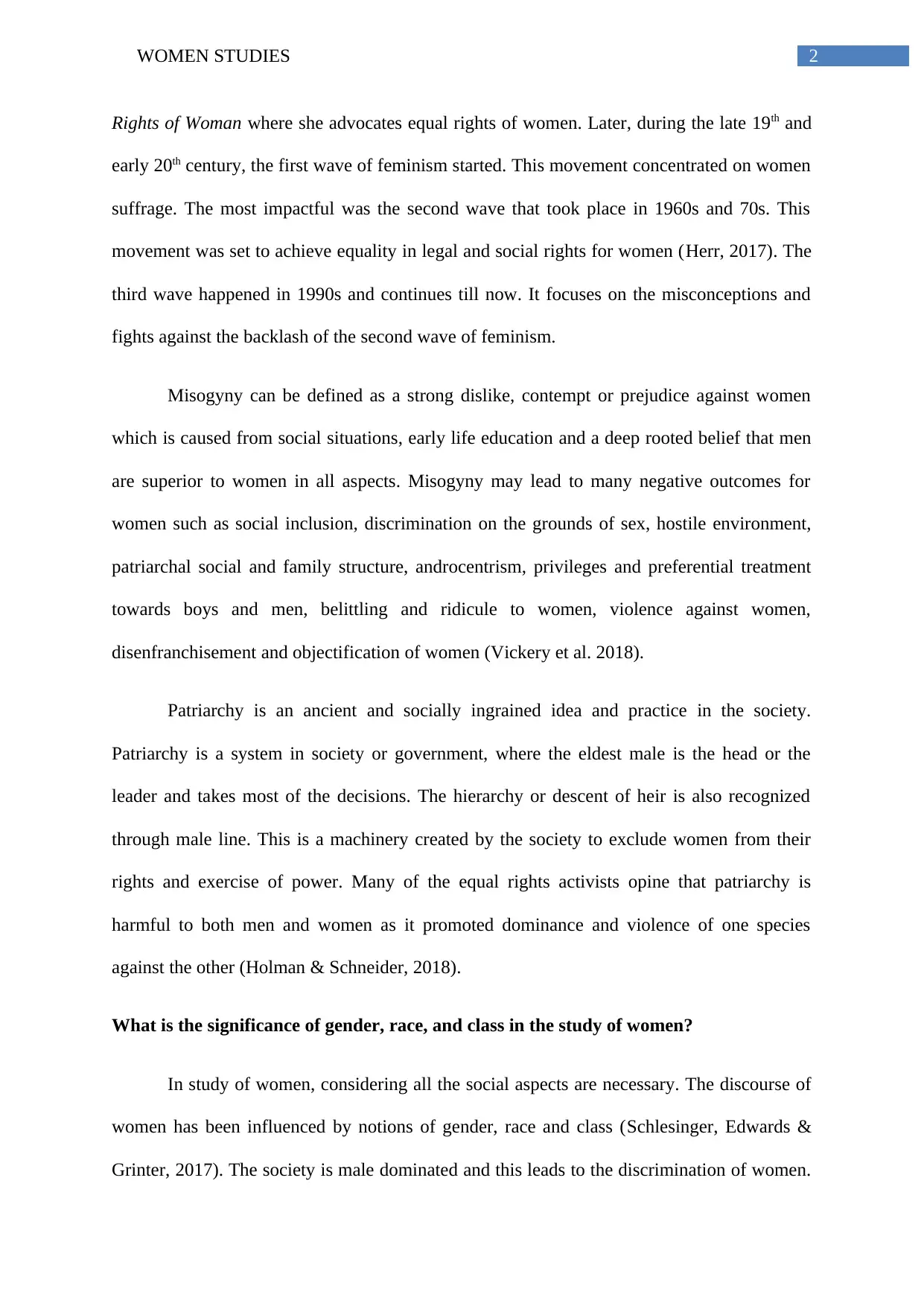
2WOMEN STUDIES
Rights of Woman where she advocates equal rights of women. Later, during the late 19th and
early 20th century, the first wave of feminism started. This movement concentrated on women
suffrage. The most impactful was the second wave that took place in 1960s and 70s. This
movement was set to achieve equality in legal and social rights for women (Herr, 2017). The
third wave happened in 1990s and continues till now. It focuses on the misconceptions and
fights against the backlash of the second wave of feminism.
Misogyny can be defined as a strong dislike, contempt or prejudice against women
which is caused from social situations, early life education and a deep rooted belief that men
are superior to women in all aspects. Misogyny may lead to many negative outcomes for
women such as social inclusion, discrimination on the grounds of sex, hostile environment,
patriarchal social and family structure, androcentrism, privileges and preferential treatment
towards boys and men, belittling and ridicule to women, violence against women,
disenfranchisement and objectification of women (Vickery et al. 2018).
Patriarchy is an ancient and socially ingrained idea and practice in the society.
Patriarchy is a system in society or government, where the eldest male is the head or the
leader and takes most of the decisions. The hierarchy or descent of heir is also recognized
through male line. This is a machinery created by the society to exclude women from their
rights and exercise of power. Many of the equal rights activists opine that patriarchy is
harmful to both men and women as it promoted dominance and violence of one species
against the other (Holman & Schneider, 2018).
What is the significance of gender, race, and class in the study of women?
In study of women, considering all the social aspects are necessary. The discourse of
women has been influenced by notions of gender, race and class (Schlesinger, Edwards &
Grinter, 2017). The society is male dominated and this leads to the discrimination of women.
Rights of Woman where she advocates equal rights of women. Later, during the late 19th and
early 20th century, the first wave of feminism started. This movement concentrated on women
suffrage. The most impactful was the second wave that took place in 1960s and 70s. This
movement was set to achieve equality in legal and social rights for women (Herr, 2017). The
third wave happened in 1990s and continues till now. It focuses on the misconceptions and
fights against the backlash of the second wave of feminism.
Misogyny can be defined as a strong dislike, contempt or prejudice against women
which is caused from social situations, early life education and a deep rooted belief that men
are superior to women in all aspects. Misogyny may lead to many negative outcomes for
women such as social inclusion, discrimination on the grounds of sex, hostile environment,
patriarchal social and family structure, androcentrism, privileges and preferential treatment
towards boys and men, belittling and ridicule to women, violence against women,
disenfranchisement and objectification of women (Vickery et al. 2018).
Patriarchy is an ancient and socially ingrained idea and practice in the society.
Patriarchy is a system in society or government, where the eldest male is the head or the
leader and takes most of the decisions. The hierarchy or descent of heir is also recognized
through male line. This is a machinery created by the society to exclude women from their
rights and exercise of power. Many of the equal rights activists opine that patriarchy is
harmful to both men and women as it promoted dominance and violence of one species
against the other (Holman & Schneider, 2018).
What is the significance of gender, race, and class in the study of women?
In study of women, considering all the social aspects are necessary. The discourse of
women has been influenced by notions of gender, race and class (Schlesinger, Edwards &
Grinter, 2017). The society is male dominated and this leads to the discrimination of women.
⊘ This is a preview!⊘
Do you want full access?
Subscribe today to unlock all pages.

Trusted by 1+ million students worldwide
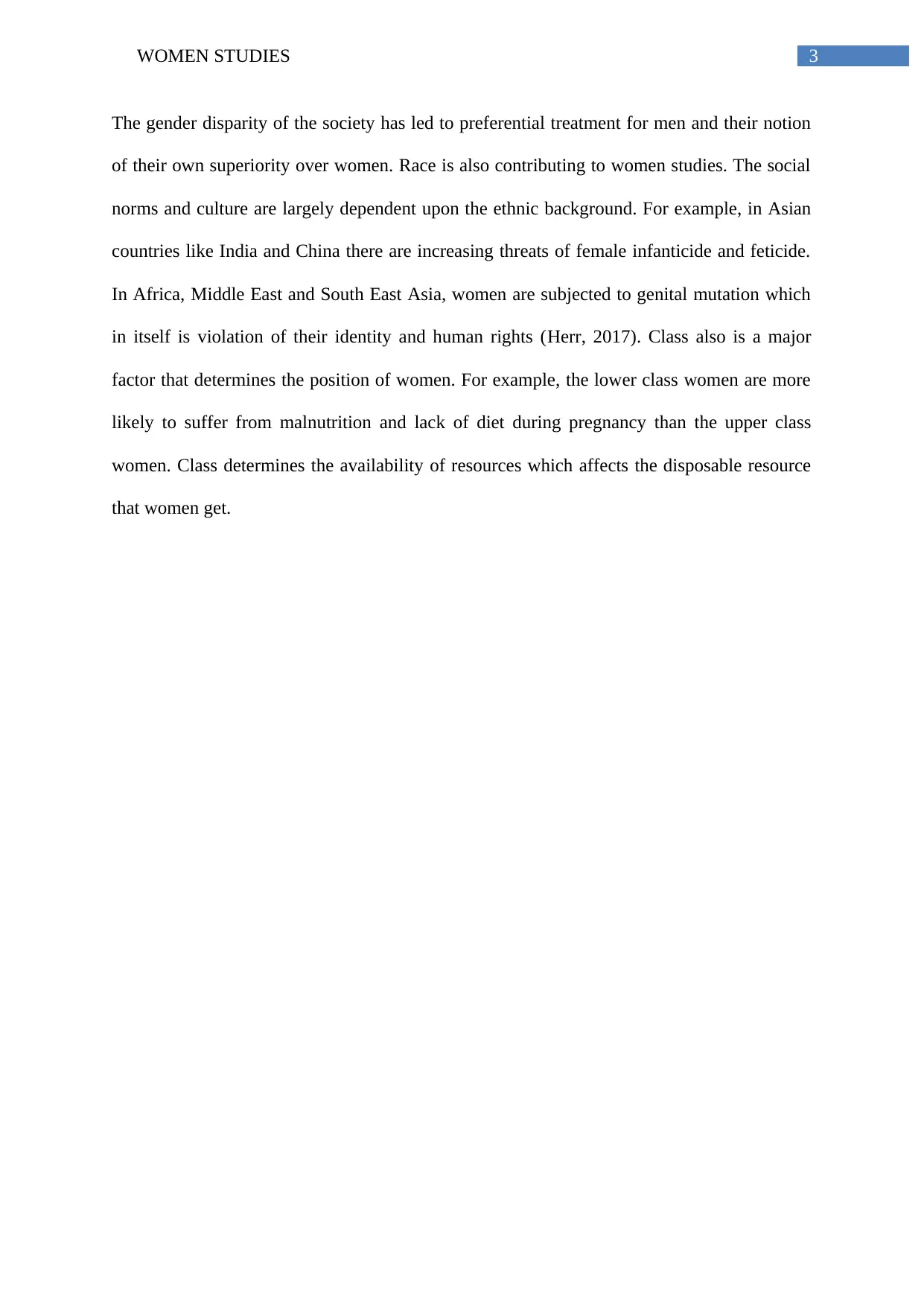
3WOMEN STUDIES
The gender disparity of the society has led to preferential treatment for men and their notion
of their own superiority over women. Race is also contributing to women studies. The social
norms and culture are largely dependent upon the ethnic background. For example, in Asian
countries like India and China there are increasing threats of female infanticide and feticide.
In Africa, Middle East and South East Asia, women are subjected to genital mutation which
in itself is violation of their identity and human rights (Herr, 2017). Class also is a major
factor that determines the position of women. For example, the lower class women are more
likely to suffer from malnutrition and lack of diet during pregnancy than the upper class
women. Class determines the availability of resources which affects the disposable resource
that women get.
The gender disparity of the society has led to preferential treatment for men and their notion
of their own superiority over women. Race is also contributing to women studies. The social
norms and culture are largely dependent upon the ethnic background. For example, in Asian
countries like India and China there are increasing threats of female infanticide and feticide.
In Africa, Middle East and South East Asia, women are subjected to genital mutation which
in itself is violation of their identity and human rights (Herr, 2017). Class also is a major
factor that determines the position of women. For example, the lower class women are more
likely to suffer from malnutrition and lack of diet during pregnancy than the upper class
women. Class determines the availability of resources which affects the disposable resource
that women get.
Paraphrase This Document
Need a fresh take? Get an instant paraphrase of this document with our AI Paraphraser
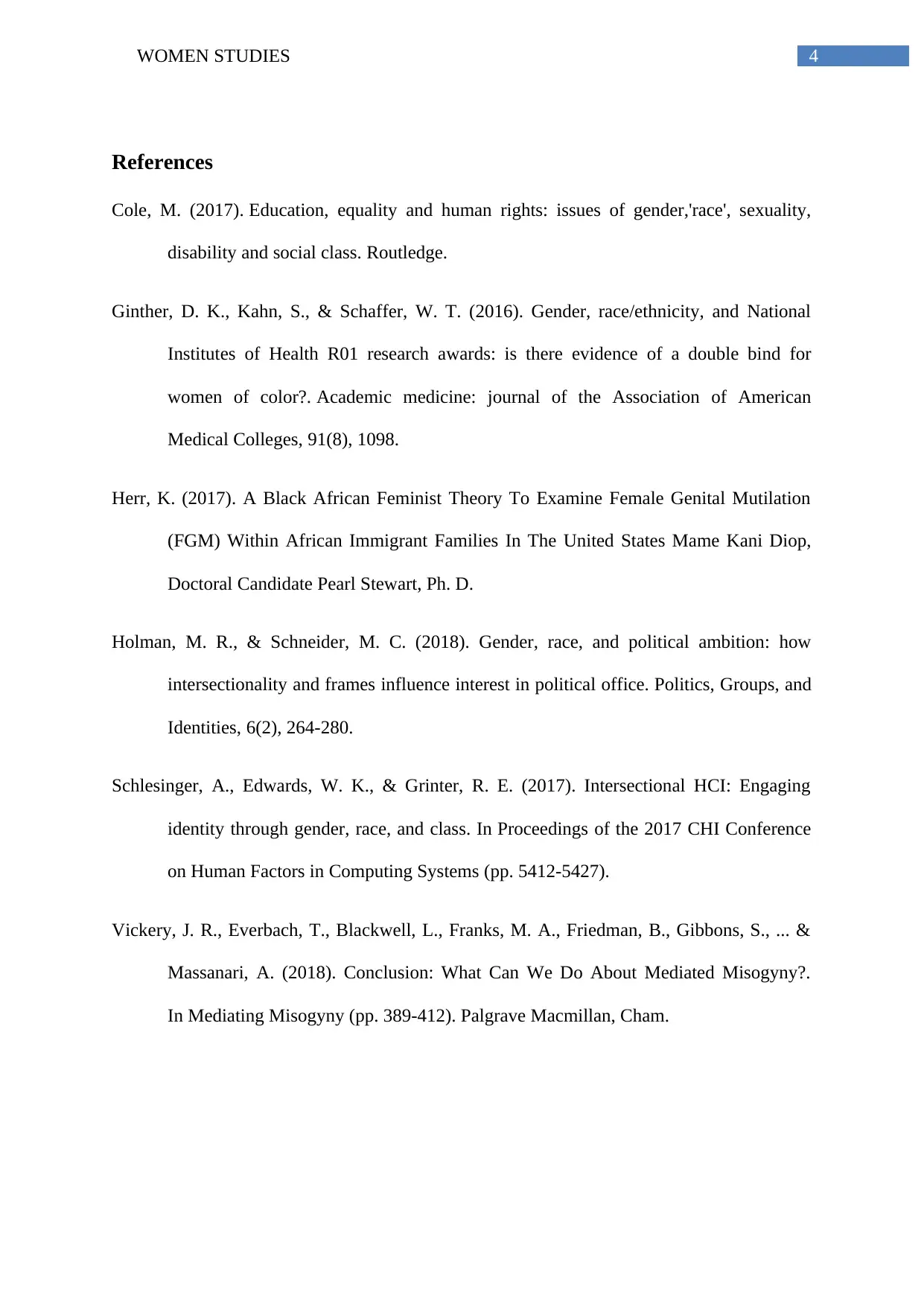
4WOMEN STUDIES
References
Cole, M. (2017). Education, equality and human rights: issues of gender,'race', sexuality,
disability and social class. Routledge.
Ginther, D. K., Kahn, S., & Schaffer, W. T. (2016). Gender, race/ethnicity, and National
Institutes of Health R01 research awards: is there evidence of a double bind for
women of color?. Academic medicine: journal of the Association of American
Medical Colleges, 91(8), 1098.
Herr, K. (2017). A Black African Feminist Theory To Examine Female Genital Mutilation
(FGM) Within African Immigrant Families In The United States Mame Kani Diop,
Doctoral Candidate Pearl Stewart, Ph. D.
Holman, M. R., & Schneider, M. C. (2018). Gender, race, and political ambition: how
intersectionality and frames influence interest in political office. Politics, Groups, and
Identities, 6(2), 264-280.
Schlesinger, A., Edwards, W. K., & Grinter, R. E. (2017). Intersectional HCI: Engaging
identity through gender, race, and class. In Proceedings of the 2017 CHI Conference
on Human Factors in Computing Systems (pp. 5412-5427).
Vickery, J. R., Everbach, T., Blackwell, L., Franks, M. A., Friedman, B., Gibbons, S., ... &
Massanari, A. (2018). Conclusion: What Can We Do About Mediated Misogyny?.
In Mediating Misogyny (pp. 389-412). Palgrave Macmillan, Cham.
References
Cole, M. (2017). Education, equality and human rights: issues of gender,'race', sexuality,
disability and social class. Routledge.
Ginther, D. K., Kahn, S., & Schaffer, W. T. (2016). Gender, race/ethnicity, and National
Institutes of Health R01 research awards: is there evidence of a double bind for
women of color?. Academic medicine: journal of the Association of American
Medical Colleges, 91(8), 1098.
Herr, K. (2017). A Black African Feminist Theory To Examine Female Genital Mutilation
(FGM) Within African Immigrant Families In The United States Mame Kani Diop,
Doctoral Candidate Pearl Stewart, Ph. D.
Holman, M. R., & Schneider, M. C. (2018). Gender, race, and political ambition: how
intersectionality and frames influence interest in political office. Politics, Groups, and
Identities, 6(2), 264-280.
Schlesinger, A., Edwards, W. K., & Grinter, R. E. (2017). Intersectional HCI: Engaging
identity through gender, race, and class. In Proceedings of the 2017 CHI Conference
on Human Factors in Computing Systems (pp. 5412-5427).
Vickery, J. R., Everbach, T., Blackwell, L., Franks, M. A., Friedman, B., Gibbons, S., ... &
Massanari, A. (2018). Conclusion: What Can We Do About Mediated Misogyny?.
In Mediating Misogyny (pp. 389-412). Palgrave Macmillan, Cham.
1 out of 5
Related Documents
Your All-in-One AI-Powered Toolkit for Academic Success.
+13062052269
info@desklib.com
Available 24*7 on WhatsApp / Email
![[object Object]](/_next/static/media/star-bottom.7253800d.svg)
Unlock your academic potential
Copyright © 2020–2025 A2Z Services. All Rights Reserved. Developed and managed by ZUCOL.





